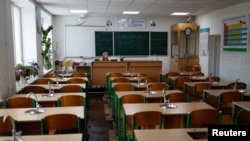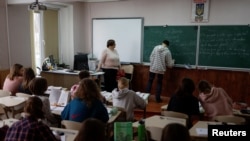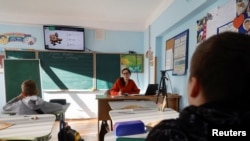Despite the missile strikes and power cuts that have become a regular occurrence in Ukraine’s capital, Kyiv’s 190,000 remaining school children are still expected to attend classes, whether online or in person.
“If there is no light, it’s sometimes hard to see when you are writing,” said Yulia, 13, sitting in the front row of an English lesson with around a dozen classmates in a western suburb of the city.
Though her school, like most buildings in Ukraine’s embattled capital, experiences regular electricity cuts caused by Russian missiles that have been targeting the power grid since October, city officials insist pupils will at least be able to finish the current semester, which ends December 23.
“We really need to hold on for these three weeks,” Oleksiy Kurpas, an adviser to the deputy head of Kyiv’s city administration, told Reuters in one of the airy yet warm corridors of the Soviet-era school.
Kurpas expressed hope that the school year would run until the summer, but the wider situation is bleak: nearly half of Ukraine’s power grid has been wrecked and Kyiv has said it expects further attacks.
The official said that about 85% of Kyiv’s prewar school staff remained in the city, compared with 60% of pupils. The other students have moved to safer regions or abroad.
As a result, schools have been working in hybrid mode both in person and online since the start of the academic year.
Online classes are attended by many students still in Kyiv, as there is still a citywide shortfall of 35,000 places in school bomb shelters where students and staff must take refuge during air raid sirens.
Lessons lost with power loss
When power goes out across the city, life is difficult for teachers and pupils alike.
Sixteen-year-old Masha, studiously taking notes during her geometry lesson, described the kind of disruption she faced.
“If the internet doesn’t work, when they give us tests, sometimes they don’t load,” she said.
The school’s head teacher, Olena Roman, said staff were sometimes unable to set homework if the power suddenly went down, and pupils learning remotely often struggled during power cuts in their homes.
Kyiv’s mobile coverage drops significantly during outages, as base stations are forced to use backup batteries with limited power reserves.
Kurpas acknowledged this was a problem and said his own child had been affected by it, but added that “all possible measures,” such as passing material through several messaging apps at once, were being taken to minimize the impact on learning.
Despite the city’s precarious situation, Roman remained confident that the school would keep teaching.
“We will continue working, without question … we have a generator, it will allow us to work in any situation, and that is what we will do,” she said.
Private schools become refuges
Kyiv’s private schools, many of which opened in the years preceding the invasion, have been able to use their greater financial resources to prepare extensively for the disruptions.
A small private school in north Kyiv has even established a heated and powered hub for parents who want to find refuge from cold, dark homes.
“After November 23, the most recent blackouts, I was able to charge my devices and get in touch with my relatives, because there was no mobile connection at home,” said Daria, a parent of one of the children at the school. “I spent all morning here … There were quite a few parents, at least 15, who used the opportunity to work, hold meetings.”
However, nothing can completely shield children from the most basic reality of war – fear.
“(During air raid sirens) I get scared because you don’t know what’s going on,” 9-year-old Daria Kosova told Reuters. “Some kids start screaming and running around, those who are more terrified, and I don’t know what to do.”



